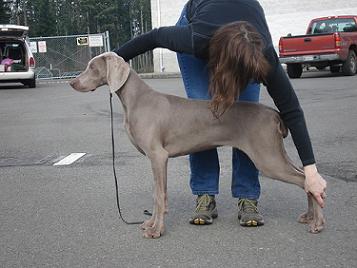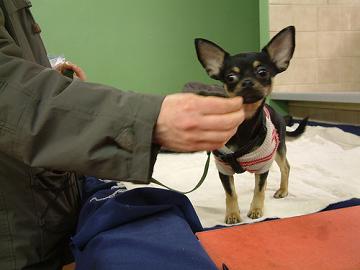Dog Obedience Training - The Stand Command
The stand command is a very handy behavior for you and your dog to have in your repertoire.
The stand command is a behavior you will call on in many different situations. It's great when you visit your Veterinarian or dog groomer. You'll also call on the stand command when bathing your dog and clipping his/her nails. It's also the best position for your dog to be in if you require him to stay for long periods.
As we do when teaching any new command/behavior we always start out in a familiar place which is free from any distractions. Make it as easy as possible for your dog when learning the stand command - then we can throw in some other variables.

Shaping The Stand Command Step-by-Step
The first step is to reward as many instances of the "stand" behavior as possible - through shaping it or simply letting is occur naturally.To begin with you should teach the stand command when your dog is in a sitting position and then from the laying down position.
| 1. Grab a few tasty treats in your hand - this will be used to lure your dog into the stand position. Your dog's nose will target the treat in your hand. With your dog sitting hold the treat a few inches in front of his/her nose. Then slowly draw it away horizontally (parallel to the ground). There is no need to say anything to your dog at this stage. If your dog responds to this lure by getting up into the stand position you should immediately reward him with a treat and some enthusiastic praise.
NOTE: If your dog does not follow your food lure you can give him some verbal encouragement, or give him a bit of a prod with your finger to get him moving. |
 |
| 2. Continue to repeat and practice this food targeting exercise - always reward a desired response. |
| 3. This next step is to get the stand behavior without using food as a lure - you will be using the food only as a reward from now on. You achieve this by continuing exactly as you have been, but this time without any food in your hand. Ok so now the process is that you put your empty hand in front of your dog's nose and slowly move it away horizontally. 9 out of 10 dogs will continue to follow your hand - even without the treat.
If your dog continues to follow, you should reward immediately with a treat from your other hand and also praise just as you have already been doing. If your dog does not follow your empty hand you can go back to giving some varbal encouragement or a bit of a prod with your finger. Once your dog is consistently following your empty hand you can cut back on the food reward. Put your dog on a variable food reward schedule - reward every second successful stand, then every third and so on. Mix it up to keep your dog guessing. |
| 4. Once your dog is solid with the process in step 3 you can add your verbal command to the stand exercise. Basically we can now get the behavior we desire (the stand), now it's time to add the verbal cue which will trigger the behavior. What you do is say "stand" then continue with the same process as in step 3. The process goes like this - say "stand", use your hand signal, then praise and reward as soon as your dog gets into the stand position. Repeat this process many times - anytime throughout the day is a good time to practice. This step builds up the association in your dog's mind between you saying "stand" and the act of him standing. |
| 5. It's now time to drop your hand signal and any other prompting and rely on your verbal cue only. Say "stand" and wait for your dog to move. It is highly likely that your dog will continue to stand just as he has been in the previous steps. He will already have made the connection between your verbal "stand" command and the act of him standing. If your dog does not move when you say "stand" your dog is not ready for this step - go back and practice step 4 some more. |
| 6. When you have the basic stand command rock solid on verbal command it's time to add some other variables. This step is all about generalizing, strengthening and proofing the stand command. What this means is that you build on the basic command to make it effective for longer periods, in a wide range of locations and in the presence of other distractions. |
If you plan to obedience train your dog at home I recommend you study and follow the cutting edge dog training methods contained here - Secrets Of A Professional Dog Trainer. You will learn exactly what makes your dog tick, how to solve common behavior problems (excessive barking, jumping up, digging etc..) and all the basic obedience training commands. Plus you get to ask a leading professional dog trainer any dog training related questions you need answered via email!
Please consult the services of a Professional Dog Trainer, Behaviorist or Veterinarian before implementing any of the advice contained on this site.







 Your Privacy Choices
Your Privacy Choices